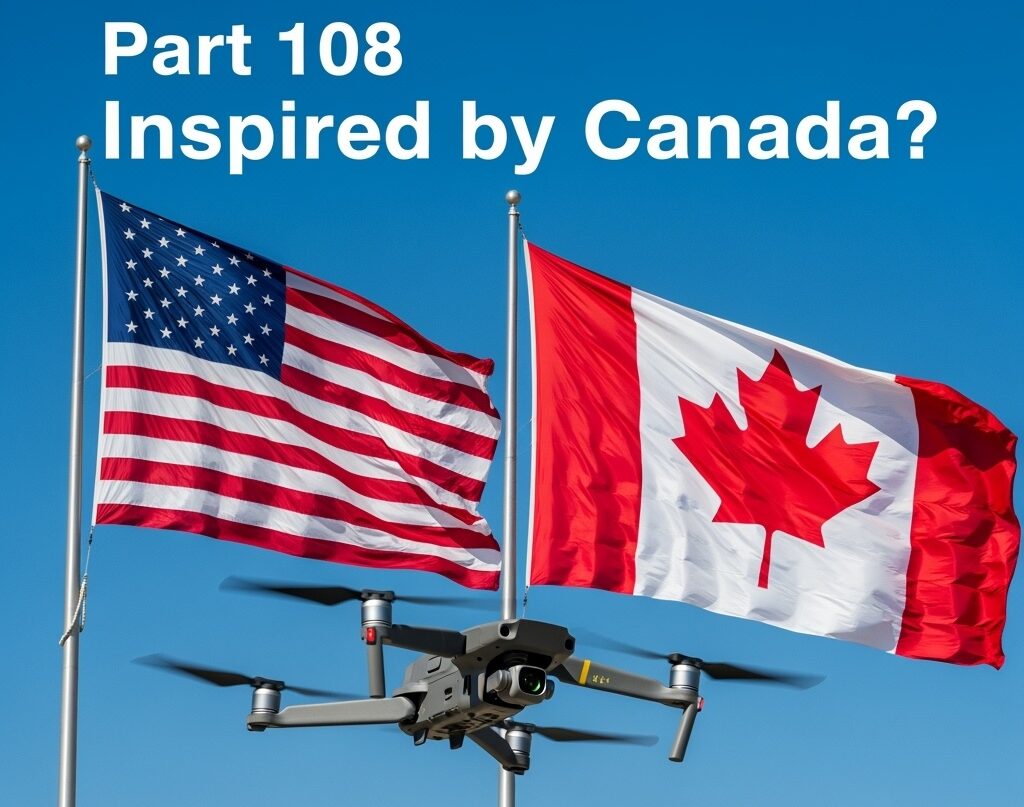By: Dan Juhlin, AG Canada Ambassador
As drone tech continues to evolve, the regulatory frameworks governing its safe integration into national airspace must evolve as well. Both Canada and the United States have been at the forefront of developing comprehensive drone regulations, with each country taking a distinct, yet iterative, approach.
While the Federal Aviation Administration (FAA) in the U.S. has long-established its foundational Part 107 rules and now announced the much-anticipated Part 108, Transport Canada (TC) has already implemented a more tiered and progressive system under Canadian Aviation Regulations (CARs) Part IX, with significant amendments for Beyond Visual Line of Sight (BVLOS) operations on the horizon. A closer examination of both CARs IX and the Part 108 NPRM reveals that Canada’s risk-based, graduated approach was in part, a blueprint for the Part 108 framework.
The Foundations: Part 107 and Canada’s Basic Operations
In the U.S., Part 107 regulations are the equivalent to Canada’s Basic Licence. Both Part 107 and Canada’s Basic Operations aim to ensure a foundational level of knowledge and safety for drone pilots conducting lower-risk operations within visual line of sight (VLOS) and keeping safe distance from people and aerodromes.
The FAA introduced Part 107, officially titled “Small Unmanned Aircraft Systems,” in 2016 to provide a regulatory pathway for commercial drone operations. It outlines requirements for remote pilot certification, operational limitations and aircraft registration for drones weighing less than 55 pounds (approximately 25 kg). To operate under Part 107, pilots must be at least 16 years old, pass an aeronautical knowledge test and undergo a TSA security screening. Any operations that fall outside of Part 107 parameters generally require a waiver, including BVLOS operations.
Similarly, TC’s CARs Part IX, enacted in 2019, introduced a two-tiered system for drone operations, with the “Basic Operations” category serving as the entry point. TC requires a Canadian Basic Operations Pilot Certificate for:
- drones weighing between 250 grams and 25 kg when operating in uncontrolled airspace
- more than 3 nautical miles from airports
- more than 1 nautical mile from heliports and
- at least 30 meters (100 feet) horizontally from bystanders.
Obtaining this certificate involves passing an online, multiple-choice exam administered through TC’s Drone Management Portal.
Canada’s Graduated Approach: The Advanced Licence
Where Canada truly diverges from the U.S. and offers a more progressive model is with its Advanced Operations Pilot Certificate, a level of certification that the U.S. currently does not have as a distinct, formalized pathway outside of the complex waiver process for Part 107.
TC designed its Canadian Advanced Licence for higher-risk scenarios to allow pilots to operate in controlled airspace, with air traffic control (ATC) authorization, closer than 30 meters to bystanders, or even over bystanders if using a drone declared safe for such operations and that meets additional requirements.
To obtain an Advanced Operations Pilot Certificate, a Canadian pilot must not only pass a more comprehensive online advanced examination (with a higher passing grade and more questions than the basic exam) but also successfully complete an in-person flight review with an approved drone flight school.
The flight review assesses the pilot’s practical skills, including flight maneuvers, emergency procedures and understanding of air law and airspace management in a real-world setting. This practical assessment ensures a higher level of pilot competency for more complex and potentially riskier operations, building a bridge between basic recreational flying and highly specialized commercial applications.
This structured progression, with increasing levels of theoretical knowledge and practical skill demonstration, provides a clear roadmap for pilots seeking to expand their operational capabilities.
Canada’s Waiver system – The Special Flight Operations Certificate
The Special Flight Operations Certificate (SFOC) provides an avenue for pilots to do operations that would otherwise be a violation of the CARs. However, unlike the US waiver system where you must apply for each specific exemption, the SFOC lets operators step outside of the regulations completely as long as one abides by the specific ruleset attached to the SFOC. One of the rules, a requirement to report back what worked and what didn’t, is a key feedback piece that has allowed Canada to move more quickly than many other nations in the development of the new regulations.
Canada’s CARs Part IX BVLOS Amendment
The most significant area where Canada stands poised to lead is in the formalization of BVLOS operations. The FAA’s proposed Part 108, which aims to streamline BVLOS in the U.S., may take at least a year to finalize. Canada’s CARs Part IX BVLOS amendment , on the other hand, is already coming into force in phases. Key changes that provide a new, structured framework for lower-risk BVLOS flights will become effective on November 4, 2025. This amendment, by moving many BVLOS operations from the realm of special, case-by-case SFOCs to a more routine, certifiable process, changes the game.
Level 1 Complex Operations
The new framework introduces the Level 1 Complex Operations certification. TC specifically designed this new pilot certification for lower-risk BVLOS operations with small and medium drones (up to 150 kg). To qualify for Level 1 Complex Operations, pilots must be at least 18 years old, pass an online exam covering advanced and Level 1 Complex Operations knowledge and complete a minimum of 20 hours of ground school, culminating in a successful flight review. This rigorous training ensures pilots possess a deep understanding of BVLOS-specific challenges, including detect-and-avoid (DAA) capabilities, command and control (C2) link management and emergency procedures.
RPAS Operator Certificate
Additionally, individuals wishing to conduct BVLOS operations under this new framework will need to be associated with an organization that has obtained an RPAS Operator Certificate (RPOC). Like an Air Operator Certificate in traditional aviation, the RPOC requires operators to establish comprehensive policies and procedures appropriate for the size and complexity of their operations, including appointing an accountable executive, outlining maintenance programs, implementing training programs and developing robust safety risk management processes. This organizational certification, combined with the individual pilot certification, creates a holistic safety management system (SMS) for BVLOS operations.
JARUS SORA
Using the JARUS SORA (Joint Authorities for Rulemaking on Unmanned Systems Specific Operations Risk Assessment) model for evaluation of risk, the Canadian BVLOS amendment will permit lower-risk BVLOS flights in uncontrolled airspace, below 122 meters (400 feet) and away from airports and aerodromes. (See prior AG coverage of the SORA in Australia). It also introduces expanded privileges for Advanced pilots, allowing for sheltered operations (flights close to structures) and extended visual line-of-sight (EVLOS) operations. EVLOS in Canada allows for the operation of drones beyond the sight of the pilot in command but within line of sight of a Visual Observer (VO) as long as the VO has constant communication with the Pilot. There is no limit to the number of VOs allowed. This is considered BVLOS in the US and requires a 107.31 waiver (for now)
This layered approach to BVLOS, differentiating between lower-risk routine operations and more complex scenarios still requiring SFOCs, provides a pragmatic and scalable path for industry growth.
The American Path Forward: Part 108
In the U.S., the FAA’s Part 108 aims to address the growing demand for more advanced drone operations, particularly BVLOS flights and cargo delivery, without the need for constant waivers. Currently, most BVLOS operations in the U.S. require a Part 107 waiver (107.31), a process that can be lengthy and resource-intensive, requiring operators to demonstrate equivalent levels of safety. Part 108 is expected to streamline this by creating a process for issuing special airworthiness certificates for uncrewed aircraft (potentially up to 1,320 pounds) and establishing operational and design requirements based on consensus standards. However, the specifics of pilot certification levels and the integration of practical flight assessments, similar to Canada’s Advanced Licence or Level 1 Complex Operations, remain to be fully detailed in the final rule.
Why Canada’s Model Provided The Blueprint
As the FAA moves forward with Part 108, it is apparent that the discussions between Transport Canada and the FAA in the fall of 2024 had a significant impact on the development of BVLOS rulemaking. There are several areas that appear to indicate a harmonization of regulations in North America.

Graduated Risk-Based Approach
Canada’s system clearly defines basic and advanced operations with distinct certification requirements, including practical flight assessments for higher-risk scenarios. The U.S. is introducing this with Part 108 including, tiered pilot certification structures beyond the single Part 107 certificate, but not necessarily with practical flight assessments integrated for advanced operations.
Proactive BVLOS Integration
Canada’s CARs Part IX BVLOS amendment is a proactive step towards normalizing lower-risk BVLOS operations, moving them from a waiver-dependent system to a certifiable one. This pre-defined pathway for BVLOS, with clear training and operational requirements, is a scalable environment for businesses compared to the current U.S. waiver system, which Part 108 also includes.
Wholistic Safety Management
The requirement for an RPAS Operator Certificate in Canada for advanced and BVLOS operations emphasizes a comprehensive SMS. This goes beyond individual pilot skills to include organizational policies, procedures, maintenance and risk assessment, mirroring the approach taken in traditional aviation. Incorporating such a requirement into Part 108 significantly enhances the overall safety posture of complex drone operations in the U.S.
Clarity and Predictability
While both countries face the challenge of rapidly evolving technology, Canada’s structured regulatory framework provides greater clarity and predictability for operators. Pilots know what steps they need to take to gain additional privileges. Businesses can plan their operations with a clearer understanding of regulatory requirements. A more defined and less waiver-dependent system in the U.S. will foster innovation and investment in the drone industry and, Part 108 appears to do just that as well.
While the FAA’s Part 107 has served as a vital starting point, the comprehensive and graduated regulatory framework developed by TC appears to have been the so-called “Easy Button” for Part 108. By embracing a tiered pilot certification system, proactively integrating BVLOS operations through structured pathways like the Level 1 Complex Operations and emphasizing organizational safety management, the U.S. can build a Part 108 that not only unlocks the full potential of drone technology but also ensures the highest standards of safety and efficiency in its airspace.
Does this mean that Canadian pilots will be able to fly in the US with a Level 1 Complex Operators Certificate? Will Part 108 Pilots be allowed to fly in Canada without an SFOC? Time will tell, but what seems to be on track for alignment of the regulations on both sides of the border is a positive step in the right direction.

